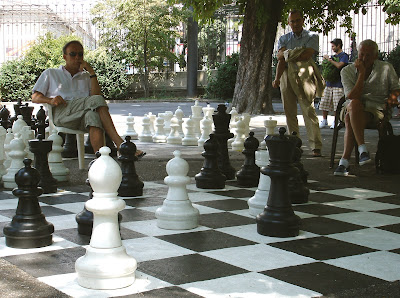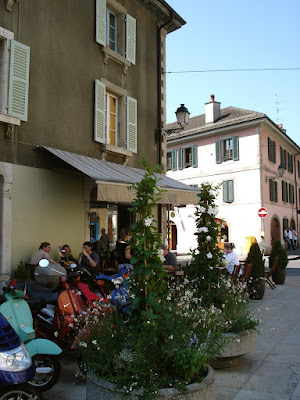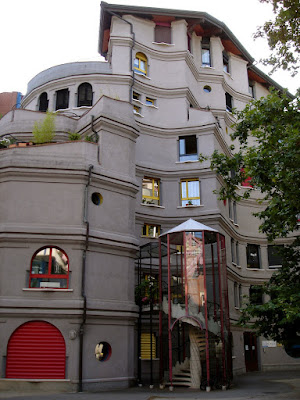What a relief to hear French again!
Since I'm trying to practice, I want to say things like grenouilles, confiture, c'est ridicule and tabernac just because I like the words (alas, they're not so easy to work into conversation...)
So I go around Geneva muttering under my breath and amusing myself. Peut-être je suis folle.
This is the flower clock. Cool. Moving on.
Geneva is strange. And I mean that in a totally pleasant, non-judgmental way of course.
The streets are big, modern-looking and weirdly deserted add odd hours of the day. Although it is august and most people are probably on vacation...
The Old Town is really nice, with lots of stairs, corners, shade and fountains.
I love that tree growing along the wall...
The Cathedral buildings are grand and imposing as usual, but lovely.
The lamp-posts are adorned with flower baskets, as are all the fountains which I think is pretty fantastic (city fountains are beautiful to start, so hats off to the swiss for upping the belle-factor another notch).
Fountain/Monuments nestled among greenery and Coca-Cola patio umbrellas.
Why doesn't every market in Europe have a pretty little carousel?
Old and new, stone and glass (above); I love how the city blocks are lined with tall grand buildings with shops and cafes strung together at street level (below).
The Botanical Garden was a cool respite from the heat: pretty paths, monuments scattered about, huge chess and checkers games, and the Reformation Wall.
On the way to the Red Cross Museum, I came across a monument to Ghandi:
And then, Musée International de la Croix-Rouge et du Croissant-Rouge:
"The open book of human thought is suspended above a heap of stones representing the earth. The characters may be different but the message - respect and love eclipsing violence and hate - is the same."
The members of the International Committee for Relief to Wounded Soldiers (regarded as the founders of the Red Cross) with Henry Dunant in the center (1863):
First meeting of the founders of the League of Red Cross Societies in Cannes France, April 1919.
The ubiquitous Red Cross Armlet, worn on the left arm:
During WWI, the International Prisoners of War Agency organized a "Red Cross Message Service" with two-part postcards allowing for a 20 word message and space for the family's reply. Some examples of postcards from WWI, featuring matronly nurses caring for soldiers, glorious battles and, later, more representative images of the wounded and destruction:
During WWII, the Red Cross was involved in so many relief operations that the stats start to blur (60 countries involved 40 million dead 179 visiting delegates 570,000 telegrams sent and recieved 45 million index cards filled in and filed 120 million messages sent and recieved 430,000 tonnes of relief to prisoners of war 877,000 tonnes for civilians), quickly slipping from memory when confronted with silk-screen images of wounded children, displaced communities and masses of soldiers, fascist footprints in the snow...
From November 1943, the ICRC was authorized to send parcels to concentration camp detainees whose name and address were known, as long as they were not in strict solitary confinement. Acknowledgments of receipt, sometimes bearing the signatures of several other detainees, enabled the committee to register about 105,000 names. By the end of the war, there had been about 11 million parcels dispatched.
The archives of the National Prisoners of War Agency (1914-1923):
Play In The Open Air, 1945.
The temporary exhibit upstairs was also really cool: Truth and Consequences, a photography exhibit about the nuclear dilema - that is, the potential for energy production alongside the potential for world catastrophe and destruction.

This is Prypyat, Ukraine - a ghost town after the Chernobyl accident.
These photos are particular resonant.
* * *
The nest day, I took a little stroll around Carouge, a pretty suburb of Geneva just across the river. It was quiet, full of artisan shops, tiny squares and small buildings.
But...by far the coolest thing I found in Geneva was an apartment complex.
Collectively the buildings are referred to as The Schtrumpfs (Smurfs!) they were built between 1982 and 1984 by three "unconventional" architects.
Monday, 28 July 2008
Geneva: Refined, Quirky and Oh So French...
Subscribe to:
Posts (Atom)



























































